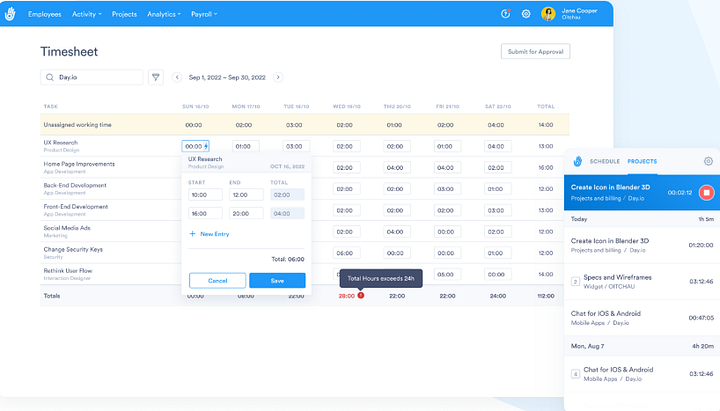Tired of manually tracking employee time and attendance? Looking to increase your business’s productivity, profitability, and accuracy? It may be time to invest in an automated timesheet system.
But before you commit, it’s essential to understand how to calculate the return on investment (ROI). With insight into costs, benefits, and factors that can impact ROI, you’ll make a smart decision that maximizes the value of your investment.
In this article, we’ll show you how to calculate ROI for a timesheet system and reveal the top advantages of using a cloud-based solution. Take advantage of increased profits and efficiency with a timesheet system that pays off!
We’ll cover the following topics throughout this article:
- What is the ROI of a Timesheet System?
- How to Calculate ROI of a Timesheet?
- Calculating the Costs of a Manual Timekeeping and Timesheet System
- Calculating the Costs of an Automated Timesheet and Timekeeping System
- Top Benefits of a Automated Cloud-based Timesheet
- Wrap-up: Leverage a Timesheet Software to Boost Profitability and ROI

What is the ROI of a Timesheet System?
Return on investment (ROI) is a metric used to measure the profitability of an investment. It’s calculated by subtracting the cost of your timesheet system from the benefits it provides, then dividing that number by the cost of your system. The result is a percentage that tells you how much return you get on your initial timesheet system purchase.
Why Should You Calculate Your Timesheet Return of Investment?
As a data-driven business leader, you must understand any significant purchase’s value. Calculating timesheet return of investment helps you make an informed decision about whether or not a timesheet system is worth investing in.
Here are some of the advantages you’ll gain by calculating ROI:
- You can assess potential improvements in productivity and profitability.
- You can identify areas where a timesheet system could help your business save money.
- You have insight into how long it will take to recoup expenses for the initial investment.
- Leveraging technology enables more accurate and timely data collection, streamlining decision-making processes.
- You’ll have concrete data to support your case for investing and communicate it to the stakeholders involved.
How to Calculate ROI of a Timesheet?
The first step in calculating the ROI of a timesheet system is to identify your current costs. Start by determining how much you spend on manual timekeeping and tracking systems. This includes labor, materials, and other expenses related to the process.
Next, determine how an automated timesheet system would impact these costs. You’ll need to ascertain the cost of the software plus any additional hardware or upgrades required for implementation. Don’t forget any associated fees, such as installation, maintenance, and training costs.
Now that you’ve established manual and automated costs for comparison purposes, it’s time to move on to the benefits. We’ll now go over calculating the ROI of a timesheet system.
Calculating the Costs of a Manual Timekeeping and Timesheet System
To calculate the ROI of a timesheet system, you must first determine the cost of your current manual timekeeping and timesheet setup. This includes any materials needed to track employee hours (e.g., paper timecards, spreadsheets) and labor costs associated with tracking, entering, and verifying data.
Let’s look at the cost factors associated with manual timekeeping and timesheets before we move on to our ROI calculator:
Paper and Materials Costs
Paper time cards, spreadsheets, and other materials needed to track employee hours can add up quickly. Even if you use free paper time cards from your local office supply store, you must factor in the cost of printing out and distributing them each pay period.
If you use a spreadsheet, you must factor in the cost of purchasing and maintaining a spreadsheet program to track employee hours. You must also consider any additional features or licenses you may need to make your system more efficient. You may also need to print out reports for your payroll department or other stakeholders, increasing the cost of materials.

Administrative and Maintenance Costs
Administrative costs associated with manual timekeeping and timesheets include hiring a staff member to manage and maintain your system. This includes payroll costs, taxes, benefits, and other related expenses. You must also consider any additional training or professional development needed to keep your system up-to-date.
Data-entry Costs
Manually entering employee time into a spreadsheet or other system can be time-consuming. You must factor in the cost of administrative labor to input data and any overtime costs associated with getting it done quickly enough to meet payroll deadlines.
Double Data Entry during Billing and Invoicing Costs
Data entry doesn’t end when the timecards are submitted. For businesses that bill clients for their employees’ labor, there is often an additional cost associated with double data entry during billing and invoicing. This includes manually entering employee hours into a separate billing system or spreadsheet and any costs associated with errors due to manual data entry (e.g., incorrect client billing).
Electronic Process Integration and Notification Costs
If you use a manual timesheet system, you must also factor in any costs associated with integrating the system with electronic processes. For example, if you want to integrate your timesheets into an invoicing or billing program, additional software licenses may be required for that integration.
In addition, if you need to send out notifications or reminders about deadlines or due dates for time entries, additional labor and communication costs may be associated with those activities.

Calculating the Costs of an Automated Timesheet and Timekeeping System
The cost of an automated timesheet and timekeeping system will depend on the specific features you need. Some typical costs you must consider for the ROI calculator, include:
Software License Fees
There are two types of software license fees associated with a timesheet system. The first is the one-time licensing cost for the software, which will depend on how many users you need to support.
The second type of fee is an annual subscription or maintenance fee that covers upgrades and technical support.
Hardware Expenses
The hardware costs associated with a timesheet system will depend on the type of solution you choose. If you opt for an on-premise or hosted solution, your costs may include servers, routers, and other equipment.
There are typically no additional hardware costs for cloud-based solutions since the vendor manages the software.
Implementation, Setup and Training Costs
If you opt for an on-premise or hosted solution, you’ll need to factor in the costs of implementation and setup. This includes expenses like installation fees, customizations, and training for your staff.
With a cloud-based solution, many vendors will provide complementary setup and training services – so be sure to ask about these options before purchasing.
Maintenance And Support Fees
Whether you opt for an on-premise or cloud solution, you must factor in maintenance and support fees. These fees cover troubleshooting, updates, and other services you may need after implementing the system.
Be sure to budget for these costs when calculating your ROI – they could affect your bottom line significantly over time.

6 Top Benefits of an Automated Cloud-based Timesheet
Once you have the cost data, you can add the benefits of an automated cloud-based timesheet system to find out the timesheet ROI. Here are some of the most common advantages:
1. Improved accuracy and tracking of employee time worked
An automated timesheet system eliminates the need for manual time tracking, which can lead to errors and inaccuracies. With a cloud-based solution, you get accurate data on employee hours worked in real time.
2. Automated payroll processing
Automating payroll with an online timesheet system helps ensure your employees are paid quickly and accurately every month. It also reduces paperwork and enables employers to manage overtime pay rules easily.
3. Increased visibility into labor costs and hours tracked
A timesheet system provides valuable insights into how much time is spent on various tasks or projects. This information can help you better control labor costs and ensure you’re always aware of your employees’ hours.
4. Reduced manual errors and paperwork
Manual time tracking is prone to human error, which can lead to inaccurate data. With an automated timesheet system, you eliminate the potential for errors while also reducing paperwork. This saves both time and money in the long run and contributes to the timesheet ROI.
5. Streamlined project management with real-time data access
Real-time data on employee hours worked is invaluable for project management. An automated system allows you to monitor progress easily and adjust schedules.
6. Enhanced compliance with regulatory requirements
Automating your timesheet system helps ensure you’re always compliant with local regulations regarding overtime pay and other labor laws. This protects both employers and employees from potential legal issues in the future.
When considering the ROI of implementing a timesheet system, it’s important to remember that not all improvements are easily quantified. It’s best to look at the overall impact of streamlining processes and reducing errors with automation, as these can majorly affect your bottom line.

For example, investing in an automated timesheet system may increase employee productivity due to reduced manual data entry and more accurate payroll calculations. This could result in greater profits for your company over time. On the other hand, purchasing a manual timekeeping system that requires more paperwork or extra steps for employees to take may not lead to increased productivity or profitability.

Wrap-up: Leverage a Timesheet Software to Boost Profitability and ROI
Investing in a timesheet system is an astute decision for businesses looking to increase their profitability and ROI. Automated timesheets reduce mistakes, streamline operations, and maximize employee productivity – all of which increase returns on investment. With careful consideration of the costs and advantages of various types of timesheet systems, you can make an informed choice that will yield considerable rewards.
Day.io offers a comprehensive timesheet and time-tracking solution for companies of any size. The cloud-based platform helps you monitor attendance, oversee projects, create reports, and more – so you can take your business to the next level. Try Day.io today and witness firsthand how our timesheet system can boost your company’s profits!

